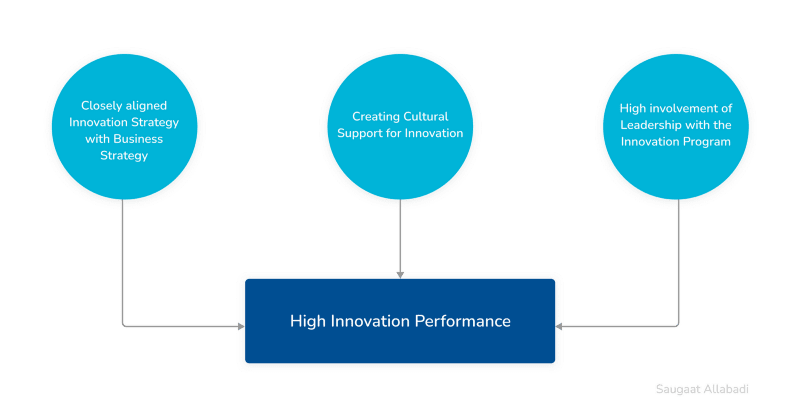Innovation is one of the areas where people are often looking for senior leadership involvement. Yet, it tends to be lacking at times.
Through this article, let’s look at the role of senior leadership and their involvement in Innovation management, why it’s important, and how should it be done.
In the words of Simon Sinek, let’s start with -
The “Why” — Why should Leadership contribute towards Innovation 🤷
Based on the research by McKinsey, 80% of executives consider their current business models to be at risk. Every year, a number of S&P 500 is replaced by other firms. This indicates that for most organizations, change is inevitable, and to remain competitive especially in these unpredictable and turbulent times, Innovation is key.
However, for the publicly listed companies, the constant pressure is to boost short-term results — the next quarter’s earnings, and that tends to affect management priorities.
Luckily, most executives understand this and already rate innovation pretty much at the top of their list of priorities, in which case they should also allocate their time and efforts accordingly.
According to Strategy+Business, top innovators are able to significantly outperform the rest of the Global Innovation 1000 (1000 largest corporate R&D spenders) across a variety of financial metrics such as revenue, operating income, and market cap growth.
According to their findings,
- They closely align innovation strategy with business strategy
- They create company-wide cultural support for innovation
- Their top leadership is highly involved with the innovation program
Let’s explore these factors to see how they play a big role in innovation performance.
1. Closely aligned innovation strategy with business strategy 🤏
The execution of innovation strategy should always be aligned with the overall business strategy across all levels of the organization.
No good executive wants a marketing strategy poorly suited for addressing the larger goals of the organization. The same holds true for innovation. The innovation strategy should be designed to help an organization reach its overall goals. If it isn’t aligned, the executives are simply gambling on the innovation program coming up with a miraculous disruptive innovation out-of-the-blue, which will then hopefully lead the organization to a new direction.
Innovation is simply about creating the future of the organization and as such, it just makes sense for top management to ensure that this work is closely aligned with the overall goals of the organization, whatever they may be.
2. Creating Cultural Support for Innovation 🤝
There are certain cultural characteristics that are generally considered to be universally beneficial for innovation, such as collaboration, work ethic, and a willingness to experiment.
However, the right culture is also dependent on the strategic goals of the organization. Cost-driven companies likely have a different culture from more value-driven companies.
The good thing is that, once the business and innovation strategies are aligned, it’s also much easier to create a singular culture that supports both of them simultaneously.
A transition to a pro-innovation culture isn’t easy and it always takes time. It typically requires some positive pressure from the top, clear communication, as well as the willingness and ability to change the day-to-day practices. Suffice to say, to have the best chance of success, cultural change too should be led from the top.
3. High involvement of Leadership with the Innovation Program 🛠️
The Leadership should never underestimate the impact their interest might have on employees’ perceptions and motivation.
If leadership shows interest in an employee’s work, they typically see it as being more important for the organization, which in turn makes the work more meaningful for the employee, and also signals to them that succeeding in it would be a great opportunity for them to shine.
In addition, by being more involved, top management can better communicate the importance of these factors and prove that the aforementioned cultural alignment is in fact in place.
The “How” — How should it be done? 🤔
Occasionally, executives withhold from taking part in innovation due to their inexperience in innovation work, or bad experiences or failures in their previous attempts at innovation.
Considering that typically CEOs come from more risk-averse and operations-focused backgrounds, such as finance, operations, and legal, they consider innovation to be one of the weakest areas of their expertise. This is quite a natural challenge to have. (One of the best solutions to deal with this is to introduce the concept of “Reverse Mentoring” in the firm — a topic I plan to cover in the future)
While top management having little experience in innovation is without a doubt a challenge, it doesn’t have to be a blocker.
As they have plenty of other priorities as well, they shouldn’t necessarily be in the trenches innovating.
Senior management simply needs to show others the way forward and then take ownership in helping their team achieve the desired results.
As ex-CEO of Google Eric Schmidt puts it -
The executives of the most innovative organizations often simply “manage chaos”.
To get there, senior managers should find a way to make sure that anyone in the organization is able to answer the following questions:
- Why is innovation important for us now and in the long term?
- What is the organization looking to achieve with it?
In addition, they need to show that they’re serious about innovation and achieving the desired results.
So, what’s next? 🚪
If you are not in a leadership position, you might be wondering about where to go from here.
If you believe that your management team should be more involved in innovation work than they currently are, you should take ownership of the situation and lead up the chain of command.
Share your concerns with the management and ask:
- Is Innovation important for the organization?
- How is it aligned with the overall strategy?
- Why isn’t senior management spending more time on it?
The conversation will serve as a starting point that you can hopefully use to start to work together to improve innovation performance.
On the other hand, if you are in a leadership position, you too need to take ownership and ask both yourself, as well as your team the following questions:
- Is Innovation important for our strategy?
- Am I spending enough/too much time on it considering what its priority is?
- Have I been able to communicate why innovation is/isn’t important for us?
- Do we have a pro-innovation culture and an aligned innovation strategy?
- Are the people in charge of innovation able to lead us to the results we want?
As mentioned above, innovation is no less than about creating the future of the organization and as such, the leadership should always be involved in it.
The extent and nature of this involvement can vary tremendously, but it most certainly needs to be there.
Here’s to finding the right approach for our organization! 🥂
Originally published at https://www.saugaatallabadi.com on January 18, 2022.








Top comments (0)